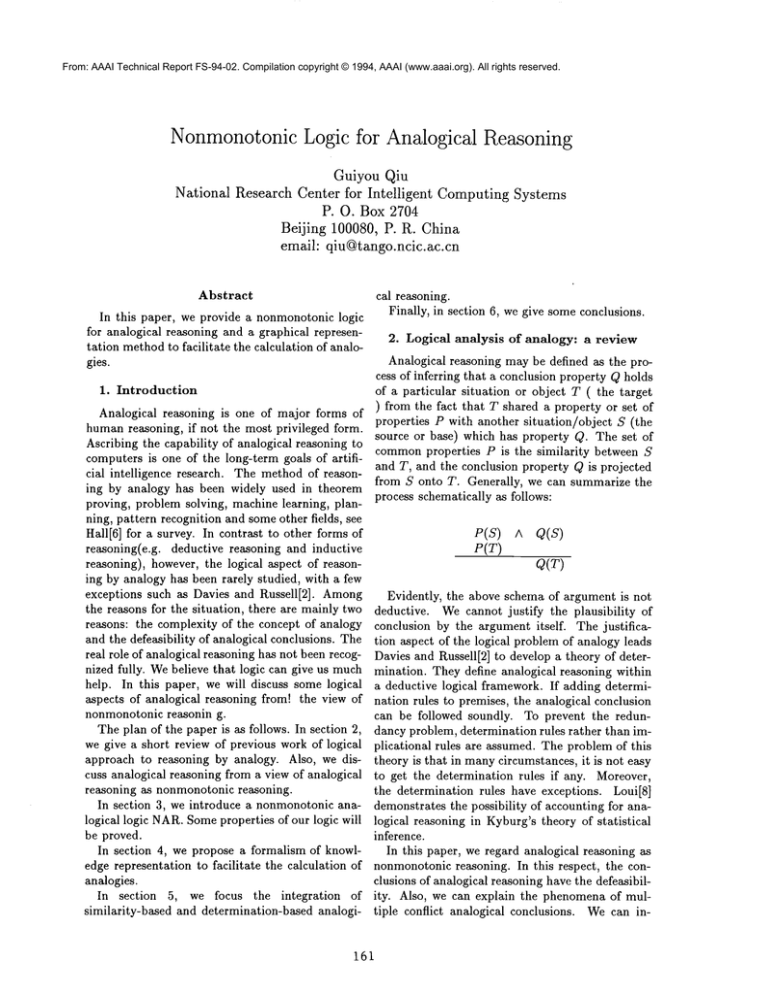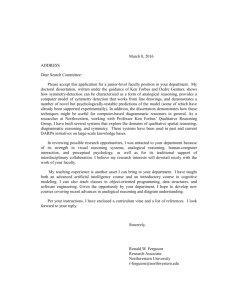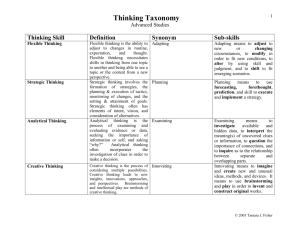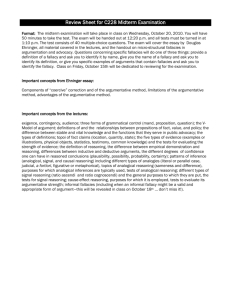
From: AAAI Technical Report FS-94-02. Compilation copyright © 1994, AAAI (www.aaai.org). All rights reserved.
Nonmonotonic
Logic for Analogical Reasoning
Guiyou Qiu
National Research Center for Intelligent ComputingSystems
P. O. Box 2704
Beijing 100080, P. R. China
emaih qiu@tango.ncic.ac.cn
Abstract
In this paper, we provide a nonmonotonic logic
for analogical reasoning and a graphical representation methodto facilitate the calculation of analogies.
1. Introduction
Analogical reasoning is one of major forms of
humanreasoning, if not the most privileged form.
Ascribing the capability of analogical reasoning to
computers is one of the long-term goals of artificial intelligence research. The method of reasoning by analogy has been widely used in theorem
proving, problem solving, machine learning, planning, pattern recognition and someother fields, see
Hall[6] for a survey. In contrast to other forms of
reasoning(e.g, deductive reasoning and inductive
reasoning), however, the logical aspect of reasoning by analogy has been rarely studied, with a few
exceptions such as Davies and Russell[2]. Among
the reasons for the situation, there are mainly two
reasons: the complexity of the concept of analogy
and the defeasibility of analogical conclusions. The
real role of analogical reasoning has not been recognized fully. Webelieve that logic can give us much
help. In this paper, we will discuss some logical
aspects of analogical reasoning from! the view of
nonmonotonic reasoning.
The plan of the paper is as follows. In section 2,
we give a short review of previous work of logical
approach to reasoning by analogy. Also, we discuss analogical reasoning from a view of analogical
reasoning as nonmonotonic reasoning.
In section 3, we introduce a nonmonotonic analogical logic NAR.Someproperties of our logic will
be proved.
In section 4, we propose a formalism of knowledge representation to facilitate the calculation of
analogies.
In section 5, we focus the integration
of
similarity-based and determination-based analogi-
cal reasoning.
Finally, in section 6, we give someconclusions.
2. Logical analysis
of analogy" a review
Analogical reasoning may be defined as the process of inferring that a conclusion property Q holds
of a particular situation or object T ( the target
) from the fact that T shared a property or set of
properties P with another situation/object
S (the
source or base) which has property Q. The set of
commonproperties P is the similarity between S
and T, and the conclusion property Q is projected
from S onto T. Generally, we can summarize the
process schematically as follows:
P(S)
P(T)
A Q(S)
Q(T)
Evidently, the above schema of argument is not
deductive. Wecannot justify the plausibility of
conclusion by the argument itself. The justification aspect of the logical problem of analogy leads
Davies and Russell[2] to develop a theory of determination. They define analogical reasoning within
a deductive logical framework. If adding determination rules to premises, the analogical conclusion
can be followed soundly. To prevent the redundancy problem, determination rules rather than implicational rules are assumed. The problem of this
theory is that in manycircumstances, it is not easy
to get the determination rules if any. Moreover,
the determination rules have exceptions. Loui[8]
demonstrates the possibility of accounting for analogical reasoning in Kyburg’s theory of statistical
inference.
In this paper, we regard analogical reasoning as
nonmonotonicreasoning. In this respect, the conclusions of analogical reasoning have the defeasibility. Also, we can explain the phenomena of multiple conflict analogical conclusions. Wecan in-
161
fer Q(T)from F = {P(S), Q(S), P(T)}, but
Given a consistent set of closed wffs F, a, b be
not obtain Q(T) from F = {P(S), Q(S), P(T)}
two terms or predicate symbols. Wesay a,b is
{-~Q(T)}. The defeasibility of analogical conclu- clusterable in F denoted by Cr(a, b), if r(a,
sions is due to the incomplete information. If we Exchange(F,a, b) is consistent.
add some default rules, we can make incomplete
Theorem 3.1.4
information complete.
Given a consistent set of wiTsF, Cr is a reflexive
and
symmetrical relation.
3. Nonmonotonic analogical logic systemNAR
Definition 3.1.5 (Similarity)
Given a consistent set of closed wits F, as, bs be
two terms or tuples of terms (with the sort s ),
say as, bs is similar in F( denoted Simr(as, bS)), if it
exists predicate symbols p8 such that both PS(aS)
In this subsection, we define a many-sorted first
order language. The definition of the language is and PS(bS) are in F.
Theorem3.1.6 For two sets of first order wffs
based on that in Thiele[13]. The purpose to use
such a language is to facilitate the definitions of F1, F2, F1 C_ F2, if Simrl(a, b) then Simr2(a, b),
where a, b are two terms or predicate symbols in L.
some concepts used in our system.
3.1 An universal
language L
many-sorted first
order
We are given the pairwise different symbols
c, v,g, q, and the set S~ with card S~ = R0. Elements of S~ are called sorts and denoted by s
(eventually with arbitrary indices ), the set S~
said to be the universal set of sorts.
Definition 3.1.7 (Relevance)
Givena consistent set of closed wffs F, a, b be two
terms or predicate symbols. Wesay a, b is analogically relevant in F denoted by Rr(a,b), if Cr(a, b)
and Simr(as, bS)).
The set of all natural numbers (including zero
is denoted by N.
Example 1 Given a consistent set of wffs S =
{P(a),-~P(b),Q(a),P(c)},
we have Rs(a,c) but
not Rs(a, b).
By the following definition, we form individual
constants, variables, functional symbols and predicate symbols.
Definition 3.1.1
1. for every s E Su and j E N,
c] is an individual constant ( of the sort s
2. for every s E Su and j E N,
vf is an individual variable ( of the sort s
3. for every s E Su and j E N,
g~ is a functional symbol ( of the type w
4. for every s E S~ and j E N,
qjWis a predicate symbol ( of the type w
Wedefine terms and formulae (denoted by A
in a similar way to other many-sorted languages.
3.2 A nonmonotonic analogical
tem NAP
logic
sys-
Definition 3.2.1 (Analogical extensions)
Let W be a set of closed wits. For any set of
closed wits S C L let F(S) be the smallest set satisfying the following three properties:
D1. WC_ r(s)
D2. TH(F(S)) = r(s)
03. If Cr(s)(a, b), Simr(s)(a , b) is true and
Cr(s)o{~p}(a,b) is false, then P E r(s) where
a, b are two terms or predicate symbols.
A set of wits E C L is an extension for W iff
Definition 3.1.2(Exchange)
Given a wffp, a, b be two terms or predicate sym- r(E) =
bols. Exchange(p, a, b) is defined as the formulas
Theorem 3.2.2
obtained by exchanging a and b in all their occurLet S be a set of consistent
wits.
If
rences in P. Similarly, we define the exchange be- Cr(s)(a, b), Simr(s)(a, not Cr(s)u{.p} (a, b) t
tween two terms or predicate symbols in a set of F(S) O {p} is consistent.
wits.
Proof. Suppose F(S) O {p} is inconsistent,
Evidently, we have the following conclusions.
have F(S) ~- -~p. Thus F(S) O -~p = F(S). This
in contradiction with the premises.
Exchange(Exchange(P, a, b), a, b)
3.3 Some properties
Exchange(P, a, a) =
Definition
Theorem 3.3.1(Exchange
extensions)
3.1.3 (Clusterabillty)
162
of NAR
is closed within the
Given a consistent set of first-order
wffs S,
a,b be two terms or predicate
symbols. If
P E £(S), Simr(s)(a, andCr(s)(a, b) t rue , then
Exchange(P, a, b) E F(S).
Proof.
It
is
enough to show that
CF(s)u-.Exchange(p,a,b)(a,
is fal se. Thelatt er is
true because F(S) U {--p} is inconsistent.
we can differentiate between the types of predicate
nodes. The arcs link the predicate nodes and term
nodes. Wegive two examples to explain the basic
ideas of our method.
Example 2.(cont.)
Graphical representation:
To well understand the behaviours of our logic,
let us consider some examples.
Example 2. Given a consistent
set of wffs
S = {P(a),-,P(b),Q(a)},
we have the following
reasoning process:
(1) Cs(P, Q)
(2) Sims (P, Q)
(3) -’CSuQ(b)(P,Q)
(4)
Example 3. Given a consistent set of wffs S =
{P(a), P(b), Q(a)}, we have the following reasoning
process:
@
Clustering:
P, Q is clusterable, a, b is not clusterable. After
the clustering, we have
C
(1) Cs(P, Q)
(2) Sims(P, Q)
(3) -~Csu-~Q(b)(P,Q)
P’Q
(4) Q(b)
For some sets of wits, there maybe multiple extensions.
Example 4. Given a consistent
set of wffs
W-- {P(a), R(a), R(c),-~P(b),-~S(b),-~S(c)},
we
have two extensions
Wt = Th(WU{’,S(a), P(c)}) and W2 Th(WU
{--P(c), R(b))).
4. Graphical
tion
representation
and computa-
From the new graph, we can obtain the conclusion -~Q(b).
Example 3. (cont.)
Graphical representation:
To facilitate the calculation of analogical conclusions, a good formalism representing the information about analogy is important. Here, we present
a graphical knowledge representation method. Our
method is inspired by the work of Pearl[23]. Similar to belief network, it is difficult to detect the
conditional independence relationship by numerical computation. Here it is difficult to detect the
clusterability relationship. Graphical representation mayreveal some important properties of clusterability. Wemust develop concepts similar to the
d-separation of belief network, etc. Further study
of this problem is beyond this paper.
Clustering:
We define types of predicate nodes and term
nodes, thus represent a theory as a graph. AcP, Q is clusterable, a, b is also clusterable. After
cording to the types of different predicate symbols, the clustering, we have
163
Q,p
Davies,T.R. and Russell, S.J. [1987] A logical
approach to reasoning by analogy. IJCAI-87,
2.
)
.
£
,
From the new graph, we can obtain the conclusion Q(b).
5. Integration
nation
of similarity
Goebel.R.[1989]
A
sketch of analogy as reasoning with equality
hypotheses, in K.P.Jantke(ed.): it Analogical
and Inductive Inference, LNCS397,243-253.
5. Greiner,R.[1988] Learning by understanding
analogies, in A. Prieditis(ed.) Analogica, 1-36.
Pitman, London.
and determi-
In our logic NAR, the determination information is ignored. One reason is that there exist some
situations where this information is not available.
Another reason is for the simplicity. In this section, we discuss the integration of similarity and
determination.
As argued by many authors[2,3,11], the determination is more important than the similarity information for establishing the validity of the analogical conclusion. Weextend our logic to deal with
this problem. The basic idea is that one agent
A makes similarity-based analogical inference, the
other agent B makes determination based analogical inference. If A get a conclusion p without confliction with the conclusion made by B, we accept
P, otherwise accept the conclusion made by B.
6. Conclusions
Davies,T.R.[1988] Determination, uniformity
and relevance: normative criteria for generalization
and reasoning by analogy, in
D.H.Helman(ed.) Analogical Reasoning, 227250. Kluwer Academic Publishers.
6. Hall,R.P.[1989] Computational approaches to
analogical reasoning: a comparative analysis.
Artificial Intelligence 39, 39-120.
7. Kodratoff, Y.[1990] Combining similarity and
causality in creative analogy, ECAI-90, 398403.
8. Loui,R.P.[1989] Analogical reasoning, defeasible reasoning and the reference class. Proc.
of Principles of KnowledgeRepresentation and
Reasoning, 256-265.
9. Pearl,J.[1988] Probabilistic Reasoningin Intelligent Systems. Morgan KaufmannPublishers,
Inc. San Mateo, Califorlia.
10. Reiter,R.[1980] A logic for default reasoning,
Artificial intelligence 13, 81-132.
In this paper, we have discussed some logical asPreliminary steps toward
pects of analogical reasoning. The major contribu- 11. Russell,S.J.[1986]
the automation of induction, AAAI, 477-484.
tions of this paper are a nonmonotoniclogic which
can make some kind of analogical reasoning and 12. Russell,S.J.[1988] Analogy by similarity, in
a formalism of knowledge representation for anaD.H.Helman(ed.) Analogical Reasoning, 251logical reasoning. Our theory provides a suitable
269. Kluwer Academic Publishers.
extendible framework to account for more logical
aspects of analogical reasoning. More specifically
13. Thiele,H.[1987] A model theoretic oriented apspeaking, both the nonmonotonic reasoning and
proach to analogy, in K.P.Jantke(ed.): it Anathe graphical representation are easily extended.
logical and Inductive Inference, LNCS265,
Acknowledgement. This work is supported by
196-208. Springer Verlag.
Chinese KR&RProject, National High-Tech Research and Development Program. Thanks to Shuo
Bai for his fruitful discussions. I wouldalso like to
thank John Case, Todd Davies, K. P. Jankte, Yves
Kodratoff and Stuart Russell for thief help.
References
1. Bai,S.[1994] A calculus for logical clustering,
to appear.
164





